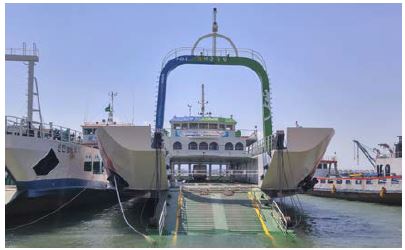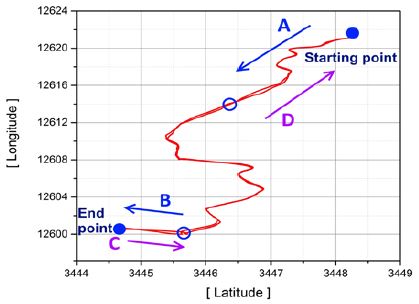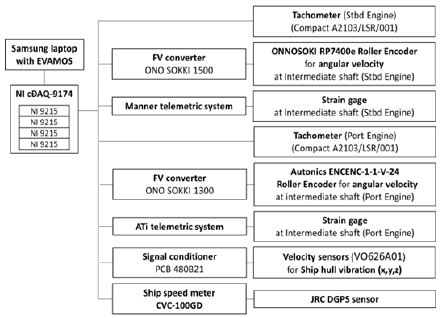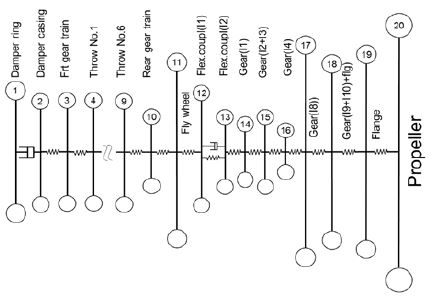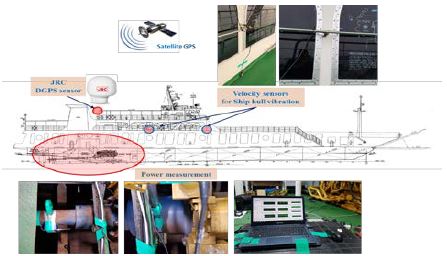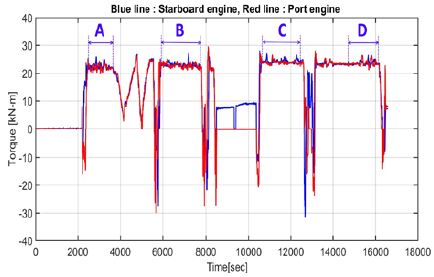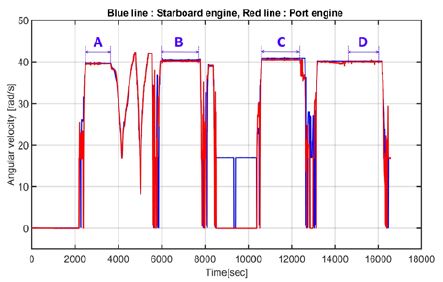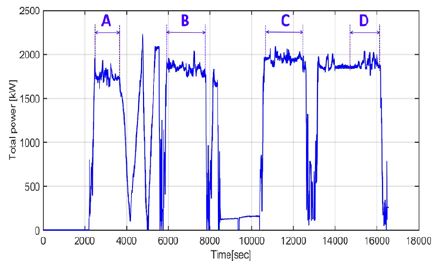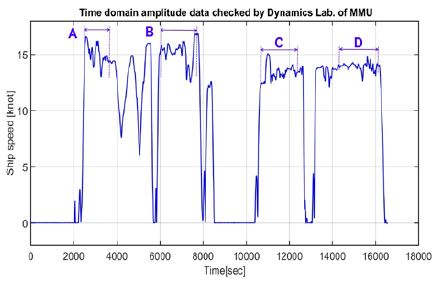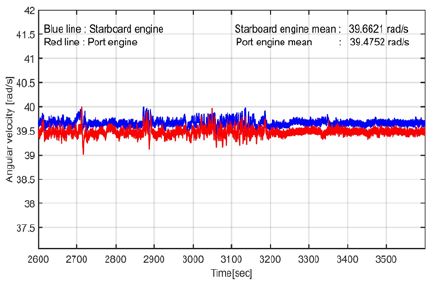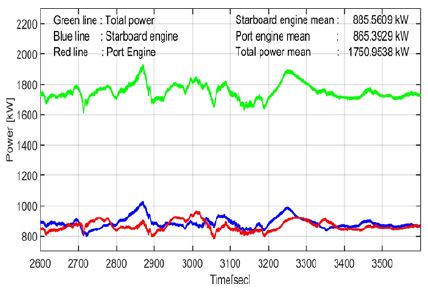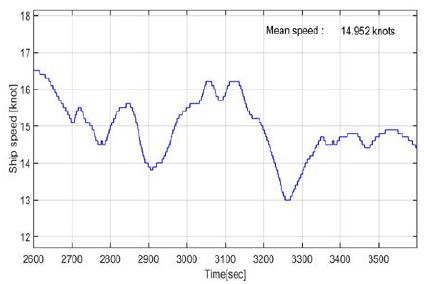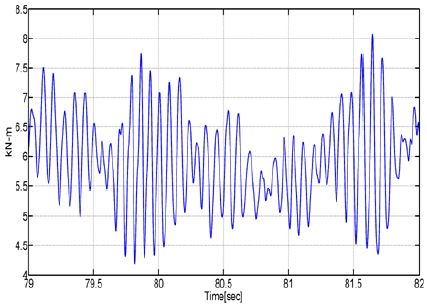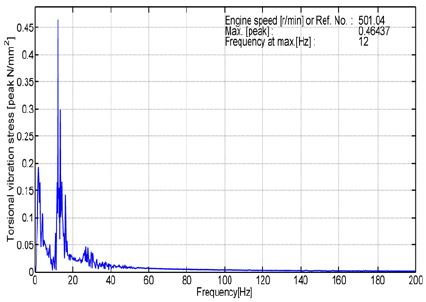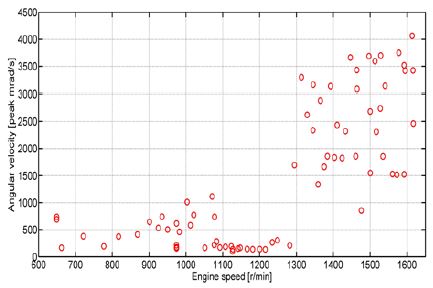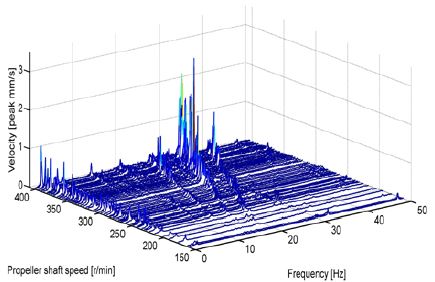
Condition diagnostics and performance estimation on a 580GT class passenger and car-ferry ship propulsion system
Copyright © The Korean Society of Marine Engineering
This is an Open Access article distributed under the terms of the Creative Commons Attribution Non-Commercial License (http://creativecommons.org/licenses/by-nc/3.0), which permits unrestricted non-commercial use, distribution, and reproduction in any medium, provided the original work is properly cited.
Abstract
Condition based maintenance method of rotating machineries generally applies vibration monitoring and analysis technique. The vibration response is an ideal source of information relevant to the machine condition. In addition, real-time vibration measurement and analysis data can provide fault diagnosis and performance of the machine. For the complex propulsion shafting system vibration monitoring, a number of components will be checked simultaneously and this necessitates a reliable and efficient monitoring system. Likewise, continuous monitoring of vibration data will require large storage capacity for the purpose of performance prediction and future investigation.
In this paper, a global vibration and ship performance measurement were carried out on a coastal trade 580GT class passenger carferry propulsion shafting system. Correlation between propulsion shafting system parameters such as ship speed, propeller shaft rpm, torque and power were analyzed. Further, the EDiMs (Energy Efficiency Design Index or Operation Index Monitoring System) and EVAMOS (Engine/Rotor Vibration Analysis and Monitoring System) software were utilized to record and analyze all measurement signals including ship position (latitude and longitude) and at the same time have the capability to store large data. Results herein are made as basis for condition diagnostics and performance estimation of the propulsion shafting system.
Keywords:
Condition diagnostics, Ship performance estimation, Vibration monitoring, Preventive maintenance1. Introduction
Different methodologies can be applied for condition diagnostics and ship performance estimation. However, most of these approaches have not considered other excitation source that contributes to the actual condition of the machine [1]. Further, an effective diagnosis should be able to detect and make reliable prediction before entering the state of the malfunction or breakdowns of the machinery [2]. Propulsion shafting system vibration analyses focus normally on identifying the dangerous resonances brought about by vibrations such as torsional, whirling or axial. These vibrations are brought about by either the propulsion shafting system mechanical components excitation or external factors. Hence, propulsion shafting vibration measurement data can be an effective source of information for condition monitoring by correlating the relationships between its parameters that include angular velocity, torque, power, ship speed and propeller shaft speed.
The relationship between power and speed plays the main role in the identification of ship’s propulsive performance. Although many scientific literatures have been published, procedures vary to confirm its relationship and produced inconsistency in its results [3]. The ISO 15016:2015 presented corrections in the analysis of speed and power measurement. In the calculation of shaft power, it should be noted the complication involved brought by onboard condition and therefore must rely on proficient technologies that operates within the permitted classifying body regulations [4]. In this paper, the speed and power relationship was investigated utilizing a vibration monitoring tool. Further, the propulsion shafting dynamic characteristics were analysed. Vibration measurement and analysis were carried out on a coastal trade 580GT class ferry propulsion shafting system with a twin-engine twopropeller configuration.
2. Ship’s propulsion performance
2.1 Experimental setup
Figure 1 shows the subject vessel runs on a round trip voyage and Figure 2 illustrates the vibration measurement data acquisition zone during its start and return trip. Likewise, indicators A and B will represent the starting route while indicators C and D the return route respectively during round trip voyage. Table 1 shows the engine and propeller specification.
Figure 3 shows the schematic diagram for the vibration measurement equipment. The mass – spring system during the normal operation mode is presented in Figure 4. The main engine is equipped with a damper while flexible coupling was installed between the flywheel and the reduction gear. Both the starboard and port engine were fitted with a strain gauge, tachometer and angular velocity encoder. It can be noted that different telemetry system was installed in order to prevent synchronization of the frequency signal affecting the data accuracy. Velocity sensors were also used for ship hull vibration and the DGPS sensor for ship speed measurement and position in real time. Acquired data were recorded and analysed using the EVAMOS (Engine/Rotor Vibration Analysis Monitoring System) software.
2.2 Data acquisition
Torsional vibration was calculated to confirm the dynamic characteristics of the propulsion shafting system including the main engine. The calculated torsional vibration stresses of the shaft along with the vibratory torques of the flexible coupling were verified to be acceptable at all engine operation range.
Power measurement was carried out by taking into account the changes in the gage resistance and, as such, torque is generated on the shaft. With the shaft speed, power can now be obtained by the equation:
| (1) |
where, P is power, T is torque, ω is the angular velocity and n is the shaft speed.
From the vibration and speed measurement, the torque by the propulsion shafting system can be seen on Figure 6 and the propeller shaft angular velocity on Figure 7 during the roundtrip voyage. Figure 8 shows the calculated power generated at each vibration measurement acquisition point of the propulsion shafting system while Figure 9 is the ship speed measurement. Again, the indicators A, B, C and D refer to the vibration measurement data.
As the propulsion shafting system involve a number of complex component, changes and deviation from standard parameters should provide the user diagnosis and prediction of the specific component. The EVAMOS program developed by the Dynamics Laboratory – Mokpo National Maritime University conforms to these requirements. The EVAMOS compact program can continuously determine the dynamic characteristic of the propulsion shafting system and function as a condition monitoring tool. Further, it also has a large storage capability to save vibration measurement data for future referencing, review and investigative purposes.
Figure 10 to Figure 13 are the parameters at Route A considered in the condition monitoring of the propulsion system. In Figure 10, the torque mean value was identified for the starboard and port main engine. The deviation occurring in this parameter can be attributed to the wear or breakdown in mechanical component of the propulsion system such as clutch and flexible coupling. Figure 11 is the measured propeller shaft angular velocity mean value. In this area, deviation can be attributed to propeller fouling, hull fouling or misalignment. The calculated power mean value is given in Figure 12 and changes in value can be attributed to the parameters above. Lastly, the ship’s mean speed is given at 14.95 knots. In reference to Figure 9, it can be observed that the ship speed at Route A and B is faster compared to Route C and D. In this area, the difference can be attributed to external factors such as sea current, wind direction and even hull fouling. All measuring results are showed in Table 2. As these results, the sea marine for power was 30% in starting route and 26% in return route.
Although the condition monitoring program have a large data storage capability, deeming only the propulsion shafting vibration measurement data at its normal operation range and its mean value will be stored, this will free up more storage.
3. Vibration and analysis [5]
In this measurement, the torsional vibration is focused in order to confirm the theoretical calculation. According to the calculated results, these propulsion systems have torsional vibration resonance in 1st node at 12.753 Hz, it is similar to the measured result (Figure 16). Figure 14 and Figure 15 show the vibratory torque curve during the ahead clutch engage. Look more detail in Figure 15, it is easy to count about 12 pulses of vibration per second. During engaging action, the torsional vibration meets the resonance at about 12 Hz, the vibration amplitude is bigger. It is recommended to change the engage speed to prevent the resonance occurring, it may result damaging the shafting system.
The calculated results also show the torsional vibration resonance in 2nd node at 33.874 Hz, it can be seen at the measured resonance of 1.5th order angular velocity of intermediate shaft showed in Figure 17. Engine should be avoided working in that resonance range. Structure vibration of navigation bridge is shown in Figure 18. Based on experience, the vibration behaviour can be improved by changing the specification of propulsion system such as changing the number of propeller blade, etc.
4. Conclusion
A global vibration and ship performance were carried out on a coastal trade 580GT class passenger car-ferry. On the other hand, condition based monitoring normally applies data acquisition and analysis. In this paper, the EDiMS and EVAMOS software were utilized to analyse both the propulsion shafting dynamic characteristic and the correlation between ship speed, torque, power and propeller shaft angular velocity. The results are as follow:
- (1) The EDiMS and EVAMOS software can continuously measure in long-term operate for ship propulsion performance estimation, machinery condition diagnostic and exhaust gases emission. It is a suitable tool for inventory and ship energy management plan, great support for Preventive Maintenance Checks and Services (PMCS).
- (2) The propulsion shafting system is a complex system but taking into account its vibration parameters such as torque, shaft speed, ship speed and power, the condition diagnosis and performance estimation can be carried out for every shafting component.
- (3) Ship speed and power is the vital factor in identifying the ship’s propulsive performance. However, the relationship between speed and power has not been fully defined.
- (4) The torsional vibration was measured in order to confirm the theoretical calculation and ship comfortability. According analysed results, the engine should be avoided operating at the resonance range. The vibration behavior can be improved by changing the specification of propulsion system such as changing the number of propeller blade, etc.
Acknowledgments
This study has been funded by the Ministry of Trade, Industry and Energy of KOREA. Also it is conducting in government project “Estabilished of authorized test and certification center for medium/high speed marine engines and related equipment”
References
- L. Zhixiong, Y. Xinping, Y. Chengqing, and P. Zhongxiao, “Intelligent fault diagnosis method for marine diesel engines using instantaneous angular speed”, Journal of Mechanical Science and Technology, vol. 26(no. 8), p2413-2423, (2012).
- L. S. Moscoso, G. Z. Villaroel, and V. S. Loja, “Statistical parameters extraction of the vibration signals of a gearbox for machine diagnosis”, Inter-noise 2015, San Francisco, California, USA, August, 9-12), IN15_921, (2015.
-
G. Strasser, K. Takagi, S. Werner, et al., “A verification of the ITTC/ISO speed / power trials analysis”, Journal of Marine Science and Technology, vol. 20(no. 1), p2-13, (2015).
[https://doi.org/10.1007/s00773-015-0304-7]

-
D. C. Lee, R. D. Barro, and J. G. Nam, “Synchronization and identification of ship shaft power and speed for energy efficiency design index verification”, Journal of the Korean Society of Marine Engineering, vol. 38(no. 2), p123-132, (2014).
[https://doi.org/10.5916/jkosme.2014.38.2.123]

- Dynamics Lab of Mokpo National Maritime University, “Torsional Vibration Calculation for Project BS15-55”, Document No. MDL-16051, (2016).

